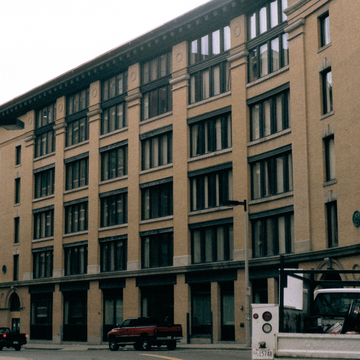A neighborhood of large brick warehouses on the southeast bank of Fort Point Channel, now home to New England's largest artists' colony, Fort Point is today surrounded by development pressures from Fan Pier, the South Boston Seaport, Boston Convention and Exhibition Center (SB10), and downtown. The Boston Wharf Company, incorporated in 1836, filled in tidal marshes on the northern side of South Boston and defined Fort Point Channel with stone seawalls, slowly creating the neighborhood. Debris from the Great Boston Fire of 1872 provided additional fill. Boston Wharf built over fifty warehouses to store coffee, ice, iron, glass, lumber, rubber, soap, sugar, and wool, as well as processing factories and printing plants. It constructed fiveto eight-story warehouses on Summer, A, and Congress streets, with smaller warehouses on side streets. The street layout included viaducts for vehicular traffic on streets above, with rail lines running below. This warehouse capacity and rail access helped Boston remain a major port through the 1920s, when manufacturing declined and truck shipments overtook rail. Today, vehicles use these multilayered streets, and five hundred artists run studios and galleries. Though Boston Wharf still owns the majority of buildings in the neighborhood, it has rehabbed many buildings for businesses and sold others.
The most impressive of the buildings are on Congress and Summer streets, especially along Melcher Street, where 253 Summer (1902) and 259 Summer (1905) follow the bend of Melcher with massive curved brick walls and ornate cornices. The brick exterior of 364–372 Congress Street (1900) is typical, but its interior, viewable by the public, is extraordinary. Originally the W. H. McElwain Shoe Manufacturing Company, it retains a magnificent central light well with criss-crossing walkways rising from the ground floor to the top floor, connecting the sides of the building. One can still imagine products from each step of manufacturing being transported across these catwalks.
Just south of Fort Point Channel District,















